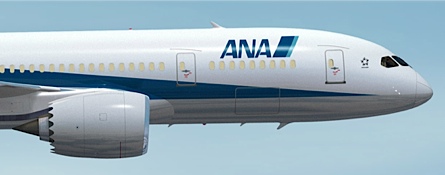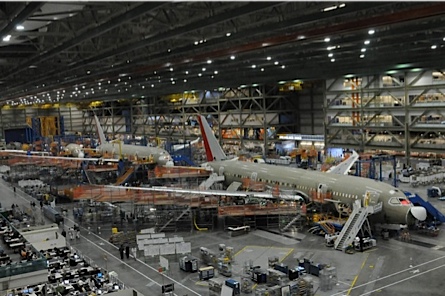After incurring two years of costly delays to its flagship programme, Boeing is set to begin final assembly of the sixth and final 787 flight-test airframe, paving the way for the first production Dreamliner.
Major supplier partners have delivered the majority of key structural and systems components to final assembly, with the forward and centre fuselage expected to be delivered around the second week of March. With these parts delivered, structural partners are, for the first time, able to focus resources solely on preparing production aircraft.
Centre fuselage integrator Global Aeronautica, for example, will have the first six production shipsets in its Charleston, South Carolina facility by mid-March.
 |
|---|
© Boeing |
Aircraft seven, which is due for delivery to All Nippon Airways in February 2010, will be the first major engineering blockpoint for the 787 programme, bringing significant weight savings for overall performance enhancement, although the first block one production aircraft are expected to be delivered over the target weight.
The second blockpoint for additional design changes and weight savings are expected for Aircraft 20. It is believed that Boeing will gain significant weight savings by introducing structural changes to the wing and a revised electric architecture.
Suppliers have described the preparation of aircraft seven for delivery to Boeing as more challenging because of the significant design revisions expected to be required for the production standard 787s.
Much of the additional work stems from revisions in the original engineering as a result of late design changes for production aircraft that will be incorporated at the first-tier supplier level, rather than further down the supply chain, where they otherwise would originate.
For example, a programme source told Flight International that the production aft fuselage sections fabricated by Vought Aircraft Industries is as much as 30% different from the first six flight-test aircraft delivered.
 |
|---|
© Tolga Ozbek |
Several such changes will originate in the centre wing box and wing tank fabricated by Kawasaki and Fuji Heavy Industries in Japan. Boeing revealed in March 2008 that it would have to strengthen internal structural spars due to premature buckling.
Boeing said at the time that aircraft seven would be the first 787 to have that change incorporated at the supplier level, whereas the first six test-flight aircraft required a retrofit to be added on the final assembly line in Everett.
In addition, to better enable the forthcoming production ramp-up and to speed up final assembly time, a terminal fitting has been relocated from the wing to the integrated centre fuselage section, although this change presented a unique challenge to the 787 supply chain.
By relocating the fitting for its first incorporation with aircraft seven, Boeing found that the width of the centre fuselage had increased, causing a "slight interference" with a damage indicator panel within the 747 LCF Dreamlifter's cargo bay, preventing optimal loading.
The interference was enough to warrant a simple retrofit to the Dreamlifter that will be prepared in time for the first delivery, which is expected in the second quarter. Boeing plans a service bulletin to address this issue across the LCF fleet.
As the programme moves into production phase, US Federal Aviation Administration audits are being conducted to ensure standardisation for type conformity of assembly and integration procedures. The aft fuselage, for example, will undergo a wiring conformity audit before delivery to final assembly.
Source: Flight International
















